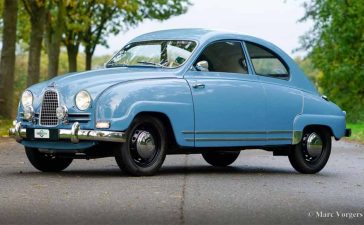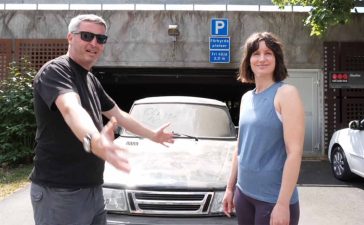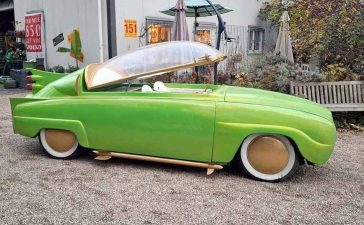How the Story Began
This story, just like every other story, has its beginning, its rise, its development toward a turning point, and inevitably, its end – which, like all endings, will come someday.
And it began long ago, in the mid-1990s, when my maternal cousin bought a Saab, the 9000 CC. In front of me stood a car with a sporty spirit wrapped in the body of an elegant four-door sedan – a vehicle that, from the very start, refused to be “like all the others.” That moment planted the seed that would grow into a journey lasting nearly two decades.

From then until today, dozens of Saabs have passed through my life and my garage. Each had its own character, its quirks, its weaknesses, and its strengths.
Why Saab Is Not Just a Car
For those who see a car merely as transportation – a machine that moves them from point A to point B and back – Saab was never the first choice. Other brands serve those needs, brands that ask for nothing more than motion. Saab, on the other hand, was never just motion. It was an emotion, an attitude, almost a philosophy of driving. Too special and too individual ever to be ordinary.

For years, I pieced this journey together in my mind, building it carefully like a director shaping a scene that deserves special attention. And then, one morning, Goran called. His voice brought the news that set everything in motion: the celebration of the 50th anniversary of the Saab Car Museum was being prepared. It was the first time I had heard about the event, and I knew this was not something to postpone. The invitation was clear – almost like a sign telling me to return to the place I had always wanted to go.

A Friendship Built on Saabs
I met Goran through Saab, and it turned out to be a friendship for life. I remember when he came to buy a car from me. It wasn’t the first Saab he owned, nor was it a particularly rare model, but in that simple exchange – in conversation and mutual understanding – a lasting friendship was born.

Later, like two schoolboys swapping trading cards during recess, we exchanged Saabs, sold them to each other, traded them, rescued them, repaired, disassembled, and reassembled them… all the things done by people united not just by a car, but by the same passion, the same story, and that special spark needed to recognize character in a cold piece of metal.
Goran is among the biggest Saab collectors in the region; his garage holds rare and valuable models, almost like a miniature museum. So it felt completely natural that the two of us would set off together on this “Saab journey.” And for us, it wasn’t just a trip – it was a kind of pilgrimage, a return to the roots of a shared passion.
Arriving in Trollhättan: The Saab Pilgrimage
And finally – we arrived at our Mecca.
Everything we had absorbed for years through photos, videos, and someone else’s words was now right in front of us, alive and real. For the first time, we stepped into a space that had existed only in our imagination.

We spent most of the day in the museum, stopping in front of each car like we were standing before a chapter of our own story. Every vehicle felt like a small time capsule – from production models to bold concept cars showing how Saab thought: always differently, and always ahead of its time.
Walking Through Stallbacka
We also visited the famous Stallbacka area, once the heart of the factory and now a ghost town. A quiet, abandoned industrial landscape, like a film set where time had stopped.

But even there, among the shadows of past production, it wasn’t hard to imagine the thunder of machines, the work shifts, the rhythm of the assembly line. The greatest paradox was watching Saabs drive through this empty space, along the very same roads where new cars once rolled out. As if the circle had closed.
Night at the Saab Museum
And then, as night fell, the spectacle began.

At the entrance, we received tickets for dinner, drinks, and a special anniversary sticker – a small souvenir, yet precious like a relic.

The nighttime program was carefully crafted, almost cinematic. Cars stood parked in dim light, while the hosts used headlights to create a play of light and shadow, like a scene filmed in a single take. The atmosphere was intimate and monumental at the same time.
Meeting Simon Padian
The central moment of the evening was Simon Padian’s lecture – the man who for years led Saab’s design studio and signed off on the design of the Saab 9-5 NG. Hearing firsthand how one of the most distinctive Saabs came to life is an experience that stays with you. No text, no video, no online story can replace the moment when the creator of a legend speaks of its birth. You realize you are looking at a person but listening to history.

A Story That Continues
Everything we experienced is just another turning point in a story that has been unfolding for nearly two decades and will continue with the same excitement until it reaches its natural conclusion someday. That ending is still far away – many gatherings, roads, meetings, and friendships lie ahead. And the friendship between Goran and me, born by chance and strengthened over the years, is now even deeper and will surely lead us into new Saab adventures.

Saab as a brand no longer exists. We will never again see a new model, nor will we have the chance to drive a car that has just rolled off the production line. But that does not mean Saab has disappeared – on the contrary, it has never been more alive. The Saab community is strong, connected, and determined to keep the remaining cars alive on the roads of Sweden, Europe, USA and the world.

And so, as long as there is at least one Saab that starts up at dawn and heads out on its way, this story will not end. And how else to conclude but with Njegoš, when speaking of something that endures despite everything:
“Hard walnut is a peculiar fruit.
You’ll not break it, but it will break your teeth.”
Text & Photos: Milija Šćepanović


















